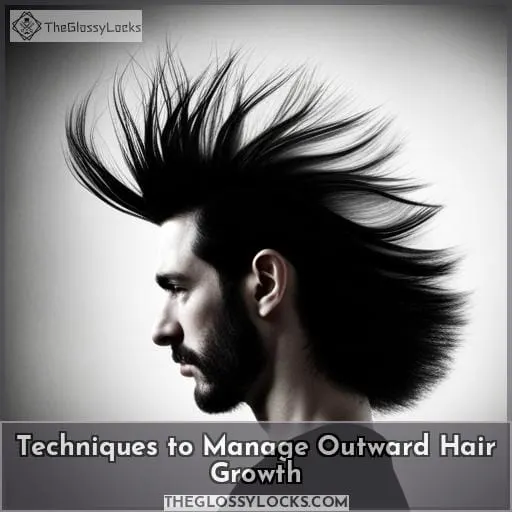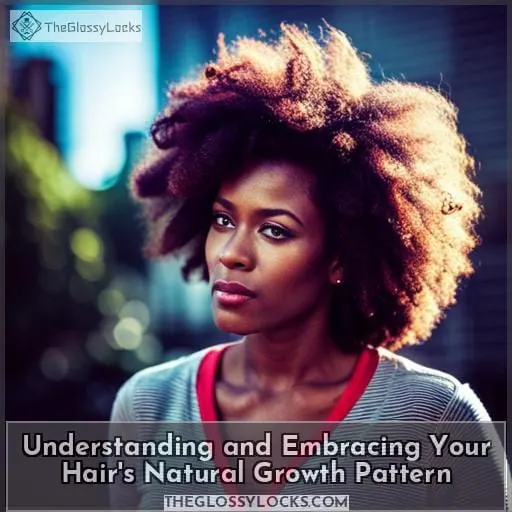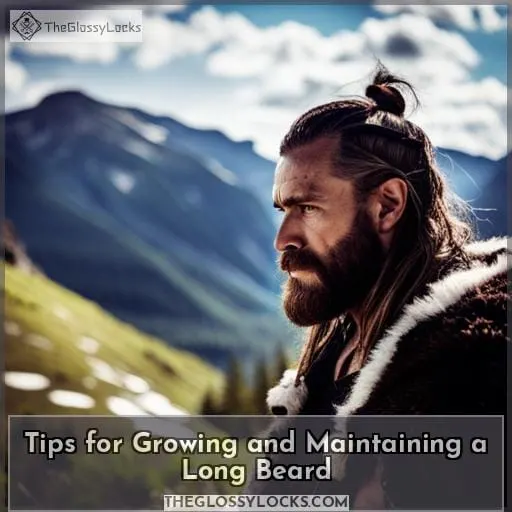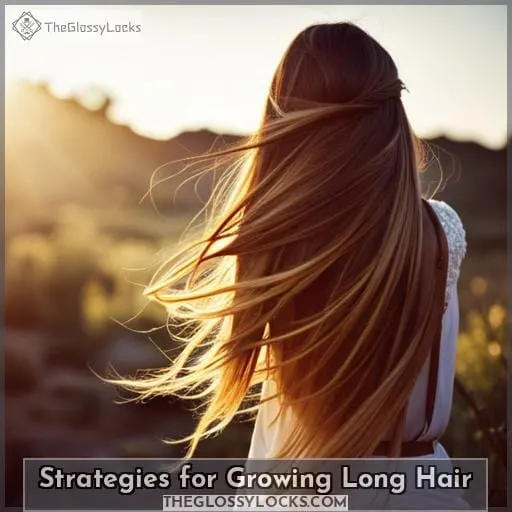This site is supported by our readers. We may earn a commission, at no cost to you, if you purchase through links.
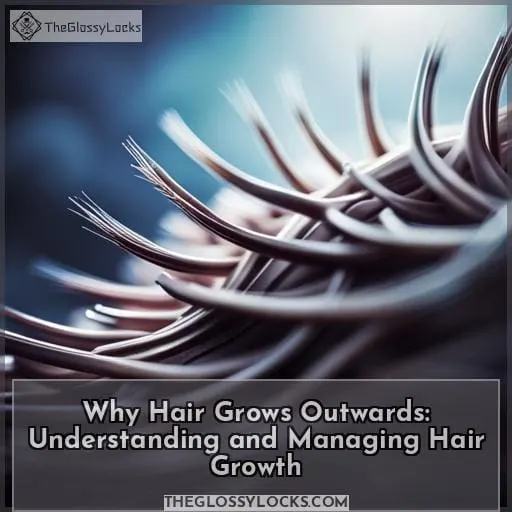
Knowing how to manage these variables can help you achieve the hairstyle you desire without compromising its health. In this article, we will discuss everything from understanding what influences outward-growing locks to techniques for managing them along with product recommendations.
So get ready: it’s time to learn about why hair grows outwards and not down!
Table Of Contents
- Key Takeaways
- The Science Behind Hair Growth Direction
- Factors Influencing Outward Hair Growth
- Techniques to Manage Outward Hair Growth
- Product Recommendations for Managing Outward Hair Growth
- Understanding and Embracing Your Hair’s Natural Growth Pattern
- Tips for Growing and Maintaining a Long Beard
- Strategies for Growing Long Hair
- Conclusion
Key Takeaways
- Hair growth direction is influenced by genetics, follicle shape, and angle.
- Curved follicles cause hair to grow outward instead of downward.
- Understanding natural hair patterns is crucial for effective management.
- Techniques like finger coils and shingling help stretch curls for outward growth.
The Science Behind Hair Growth Direction
The science behind why hair grows outwards and not down can be attributed to the shape and angle of our hair follicles, as well as genetic factors. The orientation of a person’s follicles determines whether their hairs are straight or curly; if they’re curved upwards, this will cause them to grow outward instead of downward.
In addition, genetics play an important role in determining how quickly one’s hairs grow and what type of texture they have.
Hair Follicle Shape and Angle
The shape and angle of your hair follicles determine why strands grow outwards instead of down. Outward growth factors like genetics, weather conditions, texture, and length can all impact the direction in which hairs naturally grow.
Managing these natural growth patterns is key to maintaining a desired beard or hairstyle. Understanding the basics behind hair follicle shapes and angles offers greater control over styling outcomes.
With knowledge on how to manage outwardly-growing locks, you can liberate yourself from restrictive barbershop visits. Whether you want to define curls or keep long locks neat, you can focus on self-expression with confidence.
Genetic Factors
Genetics play a significant role in determining why your hair grows outward instead of down, with some people’s follicles having an angle that naturally causes the strands to grow outward. Your inherited traits can influence beard growth phases, texture, and management; DNA also affects how quickly or slowly your hair will grow.
Genetic influences on curl pattern and hydration needs must be taken into account when developing a personalized hair care routine for lasting results.
Texture and Curl Pattern
Your curl pattern and texture influence the direction of your hair growth. Understand myths about why hair doesn’t grow down, embrace natural textures with tips for curly care, define curls using techniques like shingling and finger coils, moisturize against dryness or shrinkage with stretching methods like plopping – all to keep it growing outwards!
Factors Influencing Outward Hair Growth
When it comes to why hair grows outward and not down, there are several factors that come into play. Hair is naturally voluminous in structure, meaning the lack of weight or gravity doesn’t necessarily pull it downward.
Additionally, each person has their own unique natural hair pattern which can affect the direction of growth as well.
Voluminous Hair Structure
Embracing your voluminous hair structure can be daunting, but with patience and the right products, you’ll find yourself looking absolutely stunning. Curl-defining creams are great for achieving a sleek look and weighing down voluminous curls.
Keep in mind that moisture is key. Hydrate curly strands with deep conditioners or leave-in treatments for defined locks and healthy growth.
Don’t overlook beard care either! Consistent brushing and trimming will help maintain optimal length while also ensuring shapely lines of hair remain intact throughout its journey towards longer lengths.
Ultimately, no matter what texture you have or style goal you’re working toward, make sure it reflects who you want to be!
Lack of Weight and Gravity
By taking advantage of the lack of weight and gravity, you can achieve outward hair growth that’s full and voluminous. Weightless hair doesn’t weigh down your curls like other styling products, allowing natural patterns to be defined without being suppressed.
Stretch curls with techniques such as finger coils or shingling while avoiding heat styling for best results. Consider using heavier creams, butters, and oils to weigh down excess volume in more unruly areas.
Aim for a balance between product use and letting natural curl patterns take their course for optimal outward growth!
Natural Hair Patterns
Understanding your natural hair pattern is key to learning how to manage outward growth. Hair texture, curl patterns, and styling tips all work together for moisture maintenance and frizz control. Hair follicles are the base of hair growth; identifying the direction in which they grow helps create a plan tailored specifically for you.
Unconventional beard grooming techniques can also be used with long-term success if applied consistently.
Techniques to Manage Outward Hair Growth
Managing outward hair growth can be a challenge, especially when it comes to determining why hair grows outwards and not down. However, with the right techniques and products, you can make sure your locks remain healthy while controlling their direction of growth.
Styling Techniques for Defined Curls
Experimenting with different products and techniques can help you create defined curls that clump together and fall downward, giving your hair a less voluminous look. Shingling vs. coiling is an important technique to consider when styling curly hair.
The former works best for thin-to-medium strands, while the latter is better suited for thicker strands of curls.
Keeping moisture balance in check is crucial for maintaining healthy-looking locks. This can be achieved through deep conditioning, hydrating leave-in conditioners, and avoiding heat styling. It is also important to select appropriate products such as butters, oils, or creams based on individual needs during the product selection process.
Lastly, it is important to have realistic expectations about how your curls will behave after using these techniques.
Moisturizing and Preventing Dryness
Keep your curls hydrated and healthy with a consistent moisturizing routine! Deep conditioning treatments are key to keeping hair soft and manageable. Ensure that you use a deep conditioner at least once every two weeks, or after any chemical services.
Follow up with leave-in conditioners for extra moisture throughout the day. Try using products specifically designed for curly hair such as SheaMoisture Curl Stretch Pudding, Dark and Lovely Anti-Shrinkage Creme Glaze, or Bounce Curl Clump & Define Cream.
Incorporate beard care into your routine too; invest in a quality beard grooming kit complete with wash, oil, balm/softener combo to keep it looking fresh all day long!
Product Recommendations for Managing Outward Hair Growth
If you are looking to manage your outward hair growth, it is important to use the right products. The OGX Argan Oil Hair Mask, OUAI Leave-in Conditioner Heat Protectant, and Paul Mitchell ProTools Brush are all excellent options for this purpose.
These products will help you keep your hair hydrated, nourished, and healthy while providing definition and shine.
OGX Argan Oil Hair Mask
Try OGX Argan Oil Hair Mask; it’s beloved for its ability to nourish, hydrate, and repair dry hair. Red palm oil and cocoa butter provide frizz control, while vitamin E helps strengthen hair follicles.
This luxurious mask adds luster without greasiness and can even be used as a leave-in conditioner or curl definer in humid weather conditions! It’s the perfect choice for restoring your outwardly growing locks with moisture-rich ingredients that won’t weigh them down.
OUAI Leave in Conditioner Heat Protectant
Protect your hair with the OUAI Leave-in Conditioner Heat Protectant for all-day moisture and definition. This vegan, cruelty-free product contains amino acids and tamarind seed extract to detangle while adding shine.
Perfect for all hair types, it will help reduce frizz while protecting from heat damage. Use this conditioning treatment to maintain healthy beard hairs that are easy to brush or comb without excessive trimming when looking for a balanced maintenance routine.
Paul Mitchell ProTools Brush
For maximum control while blow-drying long or thick hair, the Paul Mitchell ProTools Brush is an ideal choice. Customers have praised its longevity, lasting over 10 years, and its performance in creating lift and volume.
Its lightweight design helps with brushing techniques that create a neat beard look in maintenance routines.
Hair growth supplements are recommended to accompany it when growing out hair for a better result. This can be combined with trimming or styling products designed for long haircare needs, such as smoothing cream to hydrate the scalp without leaving residue behind.
For overall beard grooming, this brush pairs well with other products like oil and balm as part of an effective regimen against hair loss prevention.
Understanding and Embracing Your Hair’s Natural Growth Pattern
Understanding and embracing your hair’s natural growth pattern is essential to achieving healthy, beautiful locks. Setting realistic expectations about what you can achieve with styling and products will help you work in harmony with your hair’s natural tendencies for volume, texture, and direction of growth.
Setting Realistic Expectations
Setting realistic expectations is key when it comes to embracing your hair’s natural growth pattern. Understand that you cannot alter the direction of your hair follicles, and therefore must manage outward growth with patience and persistence.
Fight shrinkage by using stretching techniques like blowouts, wet sets, plopping, or tex-laxing. Regular strategic haircuts are important for texturizing and shaping; trim split ends only instead of every stray strand.
Embracing Volume and Texture
Celebrate the unique volume and texture of your hair! Experiment with different styling products like SheaMoisture Curl Stretch Pudding or Dark and Lovely Anti-Shrinkage Creme Glaze to define curls – 80% of men have curly hair.
Balance moisture levels with regular deep conditioning, hydrate locks using leave-in conditioners, and combat shrinkage through stretching techniques. For beards, practice discipline when trimming – focus on split ends rather than every stray strand.
Keep beard shape in check by brushing regularly for control over direction while using specific products for nourishment.
Working With Your Hair’s Natural Tendencies
Embrace the voluminous and textured nature of your hair by experimenting with different styling techniques, products, and tools to achieve the desired results. Focus on working with curls using heavier products like butters or creams. Define them using shingling or finger coil methods while keeping moisture levels high for hydrated locks.
For beard training, brush regularly and use specific balms/oils to shape it into place as you grow out strands.
Tips for Growing and Maintaining a Long Beard
Growing and maintaining a long beard requires consistency in grooming routines, as well as proper brushing and combing techniques. Brushing or combing your beard regularly helps train the hairs to grow outward rather than down, resulting in a more presentable look.
By using dedicated products such as balms, oils, softeners, and washes specifically designed for beards, together with strategic trimming of split ends instead of every stray hair, you can achieve an eye-catching style that will last through all weather conditions.
Consistency in Grooming Routines
To maintain a long beard, you must be consistent in your grooming routines. Brushing and combing regularly can help keep facial hair from becoming unruly or growing oddly. Regular application of styling techniques will make maintenance easier. Trim split ends rather than every stray hair to avoid over-trimming.
Use products specifically made for beard care like wash, balm, oil, and softener.
A strategic haircut is key too. Texturize without drastic change while also maintaining your beard’s health with regular hydrating treatments.
Proper Brushing and Combing Techniques
Regularly brush and comb your beard for the best results. Detangling tips can help tame wild hairs and maintain a neat appearance. For curly hair, choose a wide-toothed comb as it gently detangles without breaking strands or exacerbating knots.
Start at the ends to separate clumps before working upwards towards the roots in small sections with slow, gentle strokes of the comb or brush. Consider investing in specially designed boar bristle brushes made from natural fibers to evenly distribute oil along your facial hair while stimulating follicles for healthy growth direction.
With proper brushing and combing techniques, you can achieve softer locks that look groomed naturally!
Strategies for Growing Long Hair
Growing long hair requires patience, planning, and regular strategic haircuts. To achieve the desired results, you should also maintain your beard growth along with your hair growth.
Patience and Planning
Making a long-term plan for your hair care journey is essential if you want to see results. Consistent beard grooming, hair care routines, and styling techniques are key elements of this plan. Use quality beard products to protect from weather effects as you grow out longer hair for men.
Regular Strategic Haircuts
Strategically trimming your hair every few months is key to maintaining a presentable look while you grow it out. Benefits of regular haircuts include texturizing, shaping, and hang time for styling techniques.
Trim split ends instead of stray hairs and incorporate beard maintenance with regular strategic haircuts. Use the right hair care products like conditioners, oils, creams, and mousse to enhance growth along with beard-specific items such as balm or waxes that will nourish follicles.
Maintaining Beard Growth Along With Hair Growth
While growing out your hair, make sure to maintain and shape your beard growth for a well-groomed look. Beard grooming requires discipline and consistency – use products like balm, wax, shears, or even dandruff shampoos to keep it healthy.
Strategic trimming of split ends is also important; don’t go overboard with the scissors! To achieve desired styles, you can experiment with different techniques such as brushing or combing in various directions until desired results are achieved.
Conclusion
Ultimately, understanding why hair grows outwards and not down is key to managing and maintaining healthy, long hair. While genetics and hair follicle shape play a role, gravity and styling techniques can also influence outward hair growth.
To achieve the best results, it’s important to invest in products specifically designed for your hair type and to use them consistently. For those growing out their hair or beards, patience and planning are key. Regular strategic haircuts and frequent brushing and combing of the beard will help maintain a presentable appearance.
Embracing your hair’s natural growth pattern is also crucial to feeling confident in your look.



